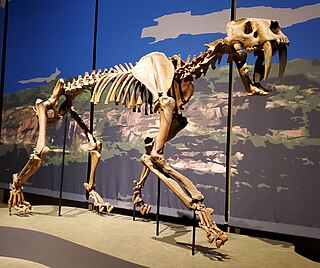
Smilodon is a genus of felids belonging to the extinct subfamily Machairodontinae. It is one of the best known saber-toothed predators and prehistoric mammals. Although commonly known as the saber-toothed tiger, it was not closely related to the tiger or other modern cats. Smilodon lived in the Americas during the Pleistocene epoch. The genus was named in 1842 based on fossils from Brazil; the generic name means "scalpel" or "two-edged knife" combined with "tooth". Three species are recognized today: S. gracilis, S. fatalis, and S. populator. The two latter species were probably descended from S. gracilis, which itself probably evolved from Megantereon. The hundreds of specimens obtained from the La Brea Tar Pits in Los Angeles constitute the largest collection of Smilodon fossils.

Tar pits, sometimes referred to as asphalt pits, are large asphalt deposits. They form in the presence of petroleum, which is created when decayed organic matter is subjected to pressure underground. If this crude oil seeps upward via fractures, conduits, or porous sedimentary rock layers, it may pool up at the surface. The lighter components of the crude oil evaporate into the atmosphere, leaving behind a black, sticky asphalt. Tar pits are often excavated because they contain large fossil collections.

The La Brea Tar Pits is an active paleontological research site in urban Los Angeles. Hancock Park was formed around a group of tar pits where natural asphalt has seeped up from the ground for tens of thousands of years. Over many centuries, the bones of trapped animals have been preserved. The George C. Page Museum is dedicated to researching the tar pits and displaying specimens from the animals that died there. La Brea Tar Pits is a registered National Natural Landmark.

The dire wolf is an extinct canine. The dire wolf lived in the Americas during the Late Pleistocene and Early Holocene epochs. The species was named in 1858, four years after the first specimen had been found. Two subspecies are recognized: Aenocyon dirus guildayi and Aenocyon dirus dirus. The largest collection of its fossils has been obtained from the Rancho La Brea Tar Pits in Los Angeles.
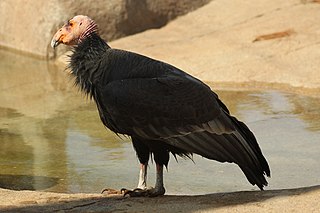
Gymnogyps is a genus of New World vultures in the family Cathartidae. There are five known species in the genus, with only one being extant, the California condor.
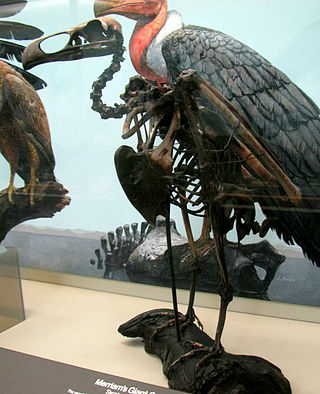
Teratornithidae is an extinct family of very large birds of prey that lived in North and South America from the Late Oligocene to Late Pleistocene. They include some of the largest known flying birds.

Hancock Park is a city park in the Miracle Mile section of the Mid-Wilshire neighborhood in Los Angeles, California.

Melanerpes is a genus of woodpeckers of the family Picidae found in the New World. The 24 members of the genus are mostly colourful birds, conspicuously barred in black and white, with some red and yellow.

Strix is a genus of owls in the typical owl family (Strigidae), one of the two generally accepted living families of owls, with the other being the barn-owl (Tytonidae). Common names are earless owls or wood owls, though they are not the only owls without ear tufts, and "wood owl" is also used as a more generic name for forest-dwelling owls. Neotropical birds in the genus Ciccaba are sometimes included in Strix.
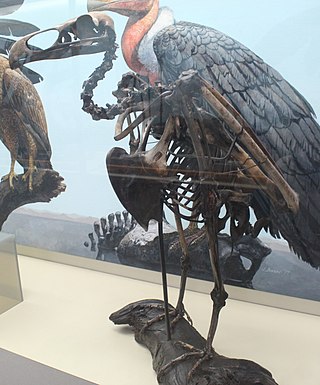
Teratornis was a genus of huge North American birds of prey—the best-known of the teratorns—of which, two species are known to have existed: Teratornis merriami and Teratornis woodburnensis. A large number of fossil and subfossil bones, representing more than 100 individuals, have been found in locations in California, Oregon, southern Nevada, Arizona, and Florida, though most are from the Californian La Brea Tar Pits. All remains except one Early Pleistocene partial skeleton from the Leisey Shell Pit near Charlotte Harbor, Florida date from the Late Pleistocene, with the youngest remains dating from the Pleistocene–Holocene boundary.
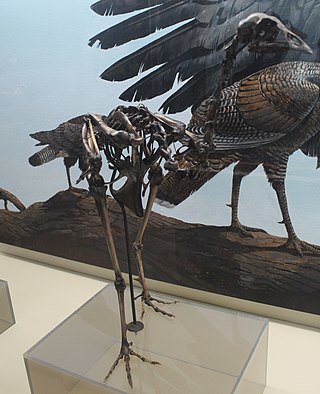
The Californian turkey is an extinct species of turkey that lived during the Pleistocene and Early Holocene epochs in California. It has been estimated that the Californian turkey went extinct about 10,000 years ago.
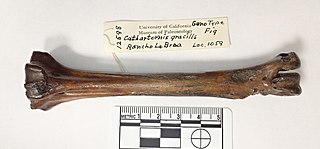
Cathartornis is an ancient bird of the Teratornithidae family. It lived somewhere between 23 million years and 10,000 years ago. The only evidence of the bird's existence is a few bones. Its remains were documented in 1910. Cathartornis was described on the basis of 2 tarsometatarsi, 1 complete and 1 containing only the distal end, recovered from the Pleistocene La Brea Tar Pits in Southern California. Since then, no other fossils have officially been referred to the taxon, though some fossils assigned to Teratornis could be from Cathartornis and unpublished remains have been mentioned.

The McKittrick Tar Pits are a series of natural asphalt lakes situated in the western part of Kern County in southern California. The pits are the most extensive asphalt lakes in the state.
Buteogallus daggetti, occasionally called "Daggett's eagle" or the "walking eagle", is an extinct species of long-legged hawk which lived in southwest North America during the Pleistocene. Initially believed to be some sort of carrion-eating eagle, it was for some time placed in the distinct genus Wetmoregyps, named for Alexander Wetmore. It probably resembled a larger version of the modern-day savanna hawk, with its long legs possibly used like the secretarybird of Africa to hunt for small reptiles from a safe distance. It died out about 13,000 years ago.
Grus pagei is an extinct crane reported from the upper Pleistocene asphalt deposits of Rancho La Brea, Los Angeles, California. It is one of three cranes present at Rancho La Brea, the others being the living whooping crane and sandhill crane. It is the smallest of the three cranes, and it had a relatively longer, more slender skull than the living cranes. At least 11 individuals are represented by 42 fossil bones. Described by Kenneth E. Campbell Jr. in 1995, it was named after the philanthropist responsible for the museum at the tar pits, George C. Page.

The asphalt miniature owl is an extinct species of true owl which existed in what is now California, U.S.A. during the Late Pleistocene epoch. The species is known from the La Brea Tar Pits. Its osteology suggests a close relation to the owls of the genus Aegolius.
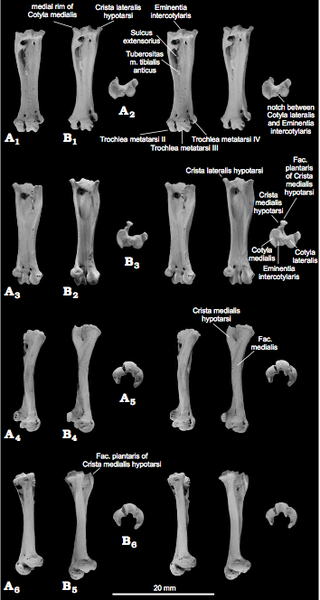
Kurochkin's pygmy owl is an extinct species of pygmy owl that existed in what is now California, U.S. during the Late Pleistocene Epoch.

Hildegarde Howard was an American pioneer in paleornithology. She was mentored by the famous ornithologist, Joseph Grinnell, at the Museum of Vertebrate Zoology (MVZ) and in avian paleontology. She was well known for her discoveries in the La Brea Tar Pits, among them the Rancho La Brea eagles. She discovered and described Pleistocene flightless waterfowl at the prehistoric Ballona wetlands of coastal Los Angeles County at Playa del Rey. In 1953, Howard became the third woman to be awarded the Brewster Medal. She was the first woman president of the Southern California Academy of Sciences. Hildegarde wrote 150 papers throughout her career.

A list of prehistoric and extinct species whose fossils have been found in the La Brea Tar Pits, located in present-day Hancock Park, a city park on the Miracle Mile section of the Mid-Wilshire district in Los Angeles, California.
Melanerpes shawi is an extinct species of woodpecker from the Pleistocene of California. It was found in the La Brea tar pits. It's part of the genus Melanerpes, which includes twenty-four extant species found across North and South America.

















